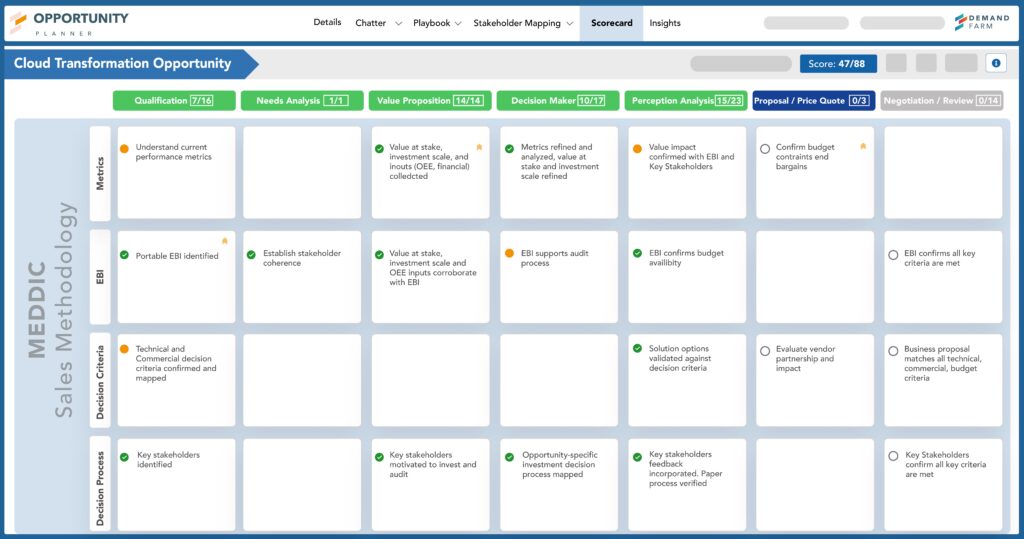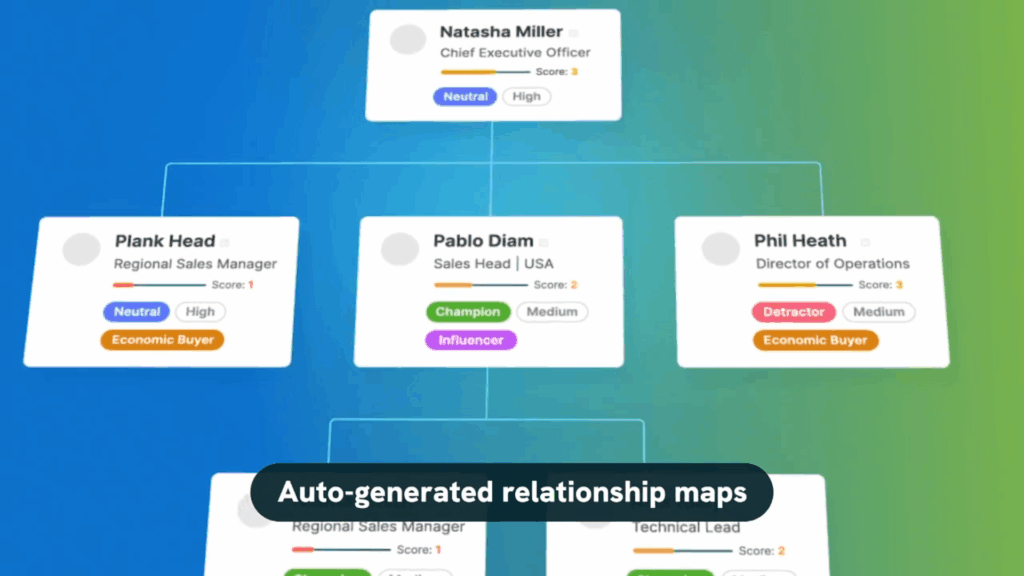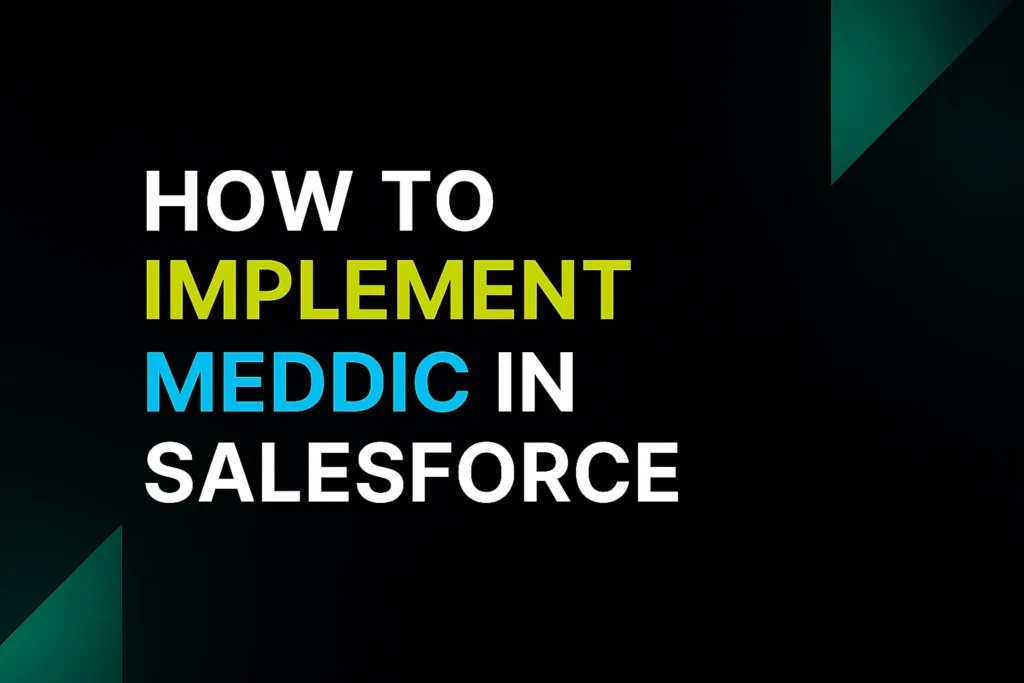Your sales team closes 23% of qualified opportunities while the industry average is 47%. That gap costs a typical $10M organization $2.4 million annually.
After working with hundreds of sales teams, I’ve seen the same pattern repeatedly: 93% of companies think they’re using MEDDIC effectively when they’re really just filling out CRM fields. They build data collection systems when they need decision-making tools.
The teams that get it right see their forecasting accuracy jump from 52% to 89% within six months. Their sales cycles shrink by 27%, and win rates increase by 34%. Here’s how to join them.
What MEDDIC Really Means
When Jack Napoli developed MEDDIC at PTC in the 1990s, he wasn’t creating another sales process. He was solving a real problem: sales reps were spending 67% of their time on deals that would never close.
The methodology came from a simple insight: enterprise deals that close all share six characteristics. Miss any of them, and you’re wasting time.
M – Metrics: The actual numbers that matter You need real ROI calculations, cost savings, and revenue increases. The kind of numbers that make economic buyers open their wallets.
E – Economic Buyer: The person who can actually spend money Not the end user who loves your product—the person who can say “yes” without asking anyone else.
D – Decision Criteria: How they’ll pick a vendor Technical requirements, business priorities, compliance needs—everything they’ll use to evaluate you against competitors.
D – Decision Process: Their internal purchasing workflow Who needs to approve what, when, and in what order. The legal reviews, procurement steps, and potential roadblocks.
I – Identify Pain: The business problem you’re solving Real business pain with consequences. The kind of problems that keep executives up at night.
C – Champion: Your advocate inside the company Someone with influence who genuinely wants you to win and can navigate internal politics.
Why Most MEDDIC Implementations Fail
I’ve seen this happen many times, and the same pattern, month by month, is committed by most of the teams.
Month 1: Sales ops creates six custom fields. Everyone feels productive.
Month 3: Only 34% of fields get filled out. Managers start nagging reps about completing MEDDIC data.
Month 6: Reps game the system with “TBD” and “In Progress”—meaningless text that satisfies validation rules.
Month 12: The whole thing quietly disappears.
The Four Problems That Kill MEDDIC
- Context Switching Reps are building relationships and solving problems, then suddenly they have to stop and fill out forms. It feels disconnected from actual selling.
- No Guidance Empty text fields don’t teach anyone how to identify economic buyers or qualify pain.
- Poor Visibility Managers can’t quickly see which deals are healthy and which are at risk.
- Silent Failures Nothing alerts anyone when deals are missing critical components.
The Right Way to Implement MEDDIC
Phase 1: Know Where You Stand (Week 1)
Before building anything new, understand your current situation.
Audit your deal quality:
- Overall win rate (industry average is 47%)
- Average deal size and 12-month trends
- Average sales cycle from first meeting to close
- Forecast accuracy vs. actual results
Review your current Salesforce setup:
- What qualification data do you already capture?
- Which fields have high vs. low completion rates?
- How do opportunities move through your pipeline?
- Where do deals typically get stuck?
Assess team readiness: Survey your team on current qualification practices. High-performing teams can identify economic buyers 87% of the time consistently, while low-performing teams struggle with basic pain qualification.
Phase 2: Build Simple Infrastructure (Week 2)
Create these custom fields on your Opportunity object:
- MEDDIC_Metrics__c (Long Text): Quantifiable business impact
- Economic_Buyer__c (Contact Lookup): Person with spending authority
- Decision_Criteria__c (Long Text): Vendor selection factors
- Decision_Process__c (Long Text): Purchasing workflow steps
- Identified_Pain__c (Long Text): Business problem being solved
- Champion__c (Contact Lookup): Internal advocate
Add a simple scoring system: Create a formula field that gives points for each completed component:
- Economic Buyer: 25 points (most critical)
- Metrics: 20 points
- Decision Criteria: 15 points
- Decision Process: 15 points
- Pain: 15 points
- Champion: 10 points
Create visual health indicators:
- 85+ points: “🟢 Qualified”
- 60-84 points: “🟡 Needs Attention”
- 30-59 points: “🟠 At Risk”
- Below 30: “🔴 Unqualified”
Phase 3: Integrate with Your Process (Week 3)
Set up stage gates: Don’t let deals advance to Proposal stage without at least 60% MEDDIC completion. Don’t let them reach Negotiation without 80% completion.
Add workflow automation:
- Alert reps when MEDDIC scores are low
- Notify managers when large deals lack qualification
- Create tasks for completing missing components
Update page layouts: Group all MEDDIC fields together with the score prominently displayed at the top.
Phase 4: Train Your Team (Weeks 4-6)
Start with managers: They need to understand how to coach using MEDDIC and how to run pipeline reviews focused on qualification quality.
Train reps systematically:
- Day 1: MEDDIC methodology (4 hours)
- Day 2: Salesforce system training (2 hours)
- Day 3: Practice with real deals (3 hours)
- Day 4: Certification and feedback
Run a pilot program: Choose 8-10 top performers to test the system before full rollout. Get their feedback and refine the process.
Phase 5: Full Deployment (Weeks 7-12)
Launch company-wide:
- Train in small cohorts (6-8 reps per session)
- Use pilot participants as peer mentors
- Stagger training to maintain sales coverage
Build reinforcement systems:
- Daily huddles review MEDDIC completion
- Weekly pipeline reviews emphasize qualification quality
- Monthly celebrations recognize MEDDIC success stories
Keep improving:
- Monthly data analysis on completion rates and outcomes
- Quarterly feedback collection and system optimization
- Continuous training gap identification
Advanced Strategies for Better Results
Visual Scorecards
Create dashboards that show:
- Individual rep MEDDIC completion rates
- Team-wide qualification health
- Deal progression correlation with MEDDIC scores
- Forecast accuracy trends by qualification level
AI-Powered Enhancement
Consider tools like DemandFarm’s Opportunity Planner that integrate with Salesforce to provide:
- Interactive org charts for relationship mapping
- AI-powered insights based on historical patterns
- Automated scoring that updates in real-time
- Enhanced visualization for better adoption
Organizations using advanced MEDDIC tools typically see:
- 94% forecast accuracy (vs. 61% baseline)
- 27% reduction in sales cycles
- 34% increase in win rates
- 89% rep adoption rate within 90 days
Measuring Success
Track these metrics:
- MEDDIC completion rate (target: 85%+ within 6 months)
- Average qualification score (target: 70%+ for deals >$10K)
- Win rate improvement (expect +15-25% within 12 months)
- Sales cycle reduction (expect -15-25% for qualified opportunities)
- Forecast accuracy (target: 80%+ monthly)
Calculate ROI: Most organizations see 150-200% ROI within 6 months and 300-500% ROI within 12 months from properly implemented MEDDIC systems.
Common Pitfalls to Avoid
The Five Implementation Killers
- Treating MEDDIC as data collection Focus on improving deal outcomes, not just filling fields.
- Insufficient manager engagement Train managers first. They need to reinforce through coaching.
- All-or-nothing rollout Always run a pilot program to prove value before full deployment.
- Ignoring change management Address resistance proactively and celebrate wins along the way.
- Lack of system integration Embed qualification into natural sales processes, don’t make it feel like extra work.
Quick Fixes for Common Issues
Low completion rates after training: Integrate MEDDIC into existing activities like calls, emails, and meetings.
Managers not using MEDDIC for coaching: Provide structured coaching conversation templates and frameworks.
Reps gaming the system: Connect MEDDIC completion to individual performance metrics, not just compliance.
Your 90-Day Success Plan
Days 1-30: Foundation
- Complete current state assessment
- Build technical infrastructure
- Train management team
- Launch pilot program
Days 31-60: Expansion
- Full team training rollout
- Process integration and refinement
- Daily reinforcement activities
- Track success metrics
Days 61-90: Optimization
- Fine-tune system based on usage data
- Implement advanced coaching
- Measure and communicate ROI
- Establish continuous improvement
The DemandFarm Advantage: Purpose-Built MEDDIC Implementation
While the manual implementation approach above works, most organizations struggle with three critical challenges: setup complexity, user adoption, and ongoing management. This is exactly why DemandFarm built its Opportunity Planner as a purpose-built MEDDIC implementation platform.
Why DemandFarm + MEDDIC Works Better
Pre-Built Intelligence vs. Custom Fields
Instead of creating custom fields from scratch, DemandFarm provides:
- Ready-to-use MEDDIC framework with optimized field structures
- Intelligent scoring algorithms that automatically calculate deal health
- Visual dashboards that surface qualification gaps instantly
- Automated workflows that guide reps through the qualification process

Smart Relationship Mapping
The biggest MEDDIC challenge is identifying economic buyers and champions. DemandFarm’s org chart functionality:
- Automatically maps stakeholder relationships from your existing contact data
- Identifies potential economic buyers based on title, department, and influence patterns
- Suggests champion candidates using engagement scoring and interaction history
- Visualizes decision-making hierarchies so reps understand the buying process

AI-Powered Qualification Assistance
DemandFarm’s AI analyzes your historical deal data to:
- Predict which deals are most likely to close based on MEDDIC completion patterns
- Surface qualification gaps before they become deal-killers
- Recommend next steps for advancing opportunities through the pipeline
- Benchmark deal health against similar successful opportunities
Implementation Timeline Comparison
Manual MEDDIC Implementation:
- Weeks 1-2: Custom field creation and setup
- Weeks 3-4: Workflow and automation configuration
- Weeks 5-12: Training, adoption, and refinement
- Months 4-6: Full team proficiency
DemandFarm + MEDDIC Implementation:
- Day 1: Platform setup and data integration
- Week 1: Team training on pre-built workflows
- Week 2-3: Pilot program with top performers
- Week 4-6: Full rollout with ongoing optimization
Real-World Results
Organizations using DemandFarm’s MEDDIC implementation typically achieve:
- 95% user adoption within 30 days (vs. 34% for manual implementations)
- 40% faster time-to-value compared to custom Salesforce builds
- 3x higher forecast accuracy due to intelligent scoring algorithms
- 25% reduction in administrative time through automated qualification workflows
What This Means for Your Team
Instead of spending 12 weeks building and refining a custom MEDDIC system, your team can:
- Start qualifying deals effectively within days of implementation
- Focus on selling activities rather than data entry and system management
- Leverage proven best practices built into the platform
- Scale qualification excellence across your entire sales organization
The choice isn’t between MEDDIC and no MEDDIC. It’s between building it yourself or using a proven platform that’s already helped thousands of sales teams transform their qualification process.
Ready to see how DemandFarm’s Opportunity Planner can accelerate your MEDDIC implementation? Book a demo and discover why leading sales organizations choose purpose-built tools over custom development.

